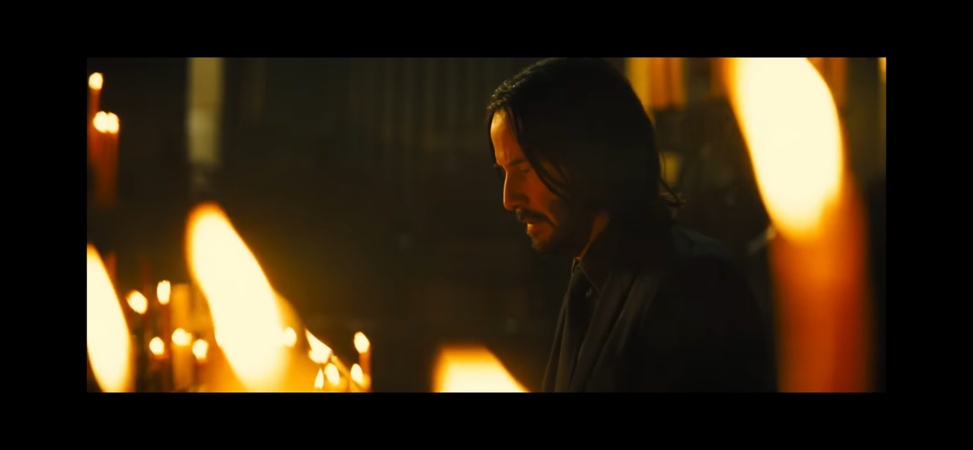Background: John Wick: Chapter 4 is a 2023 film which continues the story of a retired assassin who is forced back into his profession after the death of his dog. It is the fourth installment of the John Wick franchise. In this installment, assassin John Wick (Keanu Reeves) seeks freedom from the High Table, the clandestine organization that governs the world’s most powerful criminal syndicates. The narrative unfolds with John Wick exacting vengeance against the High Table by eliminating the Elder, who sits above the Table. This act prompts the Marquis de Gramont to take drastic measures as a reprimand to manager Winston (Ian McShane) for his failure to kill John. John challenges the Marquis to a duel, a mythical practice within the HTable’s traditions and significance, as it is a rare opportunity for John to secure his freedom. John must be part of a recognized family to legitimize his position, leading him to seek reentry into the Ruska Roma syndicate. His acceptance is contingent upon assassinating Killa Harkan, an adversary of the family, a task John completes.
Box Office:
Worldwide Gross: $440.1 million
Domestic Gross (US & Canada): $187.1 million
Budget: $100 million
Camera Techniques:
Steadicam & Tracking Shots are used multiple times to follow
the characters` movements.360-degree Rotations are used to capture and match the circular motion of the roundabout and car stunts. Slow Motion & Wide Shots emphasize stylish kills and showcase the neon-lit background. Wide Shots & Low Angles capture cars drifting and crashing at high speeds. Medium & Close-Up Shots capture the brutal hand-to-hand combat. Tilted Angles (Dutch Tilt) are used when John falls, adding to the disorienting effect.
Analysis:
The film begins with John Wick on a mission to kill the Elder, the head of the High Table. The High Table is an organized crime organization controlled by twelve criminal lords. This organization enforces rules and addresses disputes within the criminal world. Like a dictator, the Elder has power over the High Table and wields massive influence throughout the organization. The opening scene, featuring Wick’s confirmation with the Elder, begins with wide shots of the desert. John Wick, walking toward the Elder, is captured in a tracking shot of John’s movements. Toward him, John is successful in his mission; this leads the Marquis to argue with Winston about his inability to control John Wick.
As a warning, the Marquis executes Charon, Winston’s loyal concierge, thus intimidating Winston into trying harder to control the assassin. An explosion destroys the New York Continental. There were explosions on every building floor, which led to its collapse. The Continental’s destruction symbolizes the High Table’s collapse as chaos breaks out due to the death of their leader. However, as a character, John Wick is crafted into a figure to be admired. The film involves a lot of violence, such as the killing of The Elder. They are concerned that young audiences may be drawn in and participate in criminal activities. According to a study by Werner Hopf found that playing violent games led to increased violence in teens. Violence in schools is usually a combination of violent media and personal experiences of aggressive emotions. John Wick primarily focuses on avenging the death of his deceased dog. Thus, action films lead the youth to believe that violence is the best way to enact revenge. Action films can make their viewers desensitized to violence. They view violence as a normal part of life and feel less empathy for the victims of violent attracts. Bartholow et al. found that the more violent games participants played habitually, the less brain activity they showed in response to violent pictures and the more aggressively they behaved in the subsequent task. Thus, action movies can have negative impacts on society.
Caine is forced out of retirement by the High Table, which threatens to kill John Wick or his daughter. Throughout most of the movie, John Wick and Caine fight as evenly matched opponents. They are sanctioned by the High Table to a duel when they fire pistons at each other. Caine lands a shot at John Wick, badly injuring him. The duel uses a handheld camera to film John’s rapid movements. When filming both of them, they use tracking shots. The duel ends, and the High Table instructs Caine to kill the injured John; however, John Wick takes the final shot, killing the Marquis. Caine was an assassin and an old friend of John Wick; thus, both Caine’s hesitation to kill John and John’s subsequent killing of the Marquis symbolize their enduring friendship. The combat shown in the movie resembles military techniques. The High Table is similar to military organizations enforcing strict codes of conduct. However, unlike some action movies, John Wick was made without any direct involvement of the US government but still resembles the values of the military forces.
Akira is a young woman who works at her father’s hotel, The Continental. Her father’s friendship with John Wick leads them to become entangled with the criminal underworld. Her father had been hiding John Wick in the Continental from the other members of the Continental. Caine kills her father, leading to her seeking revenge. Eschholz and Bufkin (2001) compared the biological sex of movie characters to the specific gender traits listed above. They found that the characteristics of masculinity were highly correlated with violent acts shown in the movies regardless of biological sex. The assertion of the study was that female characters were masculinized when they engaged in violence. She is shown as a skilled martial artist and archer throughout the film. Her good fighting skills showcase a strength often reserved for male characters. After the death of her father, she does not cry; instead, she seeks revenge. Her revenge mirrors John Wick’s revenge after the death of his dog. Akira is a strong female character, however. She doesn’t interact with any of the other women in the movie. The film doesn’t pass the Bechdel test as it focuses on its male characters. John Wick primarily targets men, as they are the primary consumers of the film. Blanchard et al. (1986) presented their participants with violent material from various sources or genres, including a spy movie, a war movie, a Western movie, and a cartoon. Thus, it may be why female characters are given less significance in action films. It was suggested that observers, especially those who identify with a major protagonist, tend to enjoy films more if they can relate to a character of the same sex (Hoffner, 1996). Content analyses showed that male protagonists dominate in film genres and that men prefer.
John Wick is a film that centres around themes of duty and revenge. The film shares similarities with the military in its operational structure and the fighting techniques depicted. John Wick contains violence, which can lead to the desensitization of viewers as they no longer react emotionally to violence. Desensitization can lead to the normalization of violence in society. John Wick is a male-centred plot, which means the female character barely has screen time. Akira is highlighted in the script; however, she doesn’t speak with the two female characters. Thus, the film fails the Bechtel test. John Wick: Chapter 4 is still an enjoyable experience to watch.
References
Blanchard, D. Caroline, Barry Graczyk, and Robert J. Blanchard. “Differential reactions of men and women to realism, physical damage, and emotionality in violent films.” Aggressive Behavior 12, no. 1 (1986): 45-55.
Hoffner, Cynthia. “Children’s wishful identification and parasocial interaction with favourite television characters.” Journal of Broadcasting & Electronic Media 40, no. 3 (1996): 389-402.
Eschholz, Sarah, and Jana Bufkin. “Crime in the movies: Investigating the efficacy of measures of both sex and gender for predicting victimization and offending in film.” In Sociological Forum, vol. 16, pp. 655-676. Kluwer Academic Publishers-Plenum Publishers, 2001.
“John Wick: Chapter 4 – Box Office Mojo.” n.d. Box Office Mojo. https://www.boxofficemojo.com/title/tt10366206/news/.
Hopf, Werner H., Günter L. Huber, and Rudolf H. Weiß. “Media violence and youth violence: A 2-year longitudinal study.” Journal of Media Psychology 20, no. 3 (2008): 79-96.
Bartholow, B. D., Sestir, M. A., & Davis, E. B. (2005). Correlates and consequences of exposure to video game violence: hostile personality, empathy, and aggressive behaviour. Personality & Social Psychology Bulletin, 31(11), 1573–1586. https://doi.org/10.1177/0146167205277205


Ricardo Alexandesr Munoz Cazare
Explain the analysis of John Wick: Chapter 4
I agree with the analysis presented in the review. It is capable of inferring the overall themes of John Wick: Chapter 4, including John’s pursuit of independence, John’s battle against the High Table, and symbolism of events like the destruction of the Continental. It is capable of expressing a good understanding of the plot and emotional connection of characters, including that between John and Caine.
The academic resources employed were applicable and contributed significantly to the discourse. The employment of research from Werner Hopf and Bartholow is educative in terms of media violence and its implications on younger audiences. The employment of Eschholz and Bufkin also provided a valuable gendered interpretation, especially in examining the character of Akira and the film’s failure in the Bechdel test.
On aesthetic grounds, the account also pays a good balance to the film’s look. The use of film technique in the form of steadicam, 360-degree, and Dutch tilt precisely fits the action of the movie as stylised and dynamic. Such technical matters helped further in informing the reader about how tension and suspense within the film was built.
Overall, the critique is well-integrated, insightful, and firmly based on scholarship. It is well-positioned to be able to credibly place John Wick: Chapter 4 as both visually striking and thematically rich action film.